Jiayi Zhou
Ultra-Low Complexity On-Orbit Compression for Remote Sensing Imagery via Block Modulated Imaging
Dec 24, 2024Abstract:The growing field of remote sensing faces a challenge: the ever-increasing size and volume of imagery data are exceeding the storage and transmission capabilities of satellite platforms. Efficient compression of remote sensing imagery is a critical solution to alleviate these burdens on satellites. However, existing compression methods are often too computationally expensive for satellites. With the continued advancement of compressed sensing theory, single-pixel imaging emerges as a powerful tool that brings new possibilities for on-orbit image compression. However, it still suffers from prolonged imaging times and the inability to perform high-resolution imaging, hindering its practical application. This paper advances the study of compressed sensing in remote sensing image compression, proposing Block Modulated Imaging (BMI). By requiring only a single exposure, BMI significantly enhances imaging acquisition speeds. Additionally, BMI obviates the need for digital micromirror devices and surpasses limitations in image resolution. Furthermore, we propose a novel decoding network specifically designed to reconstruct images compressed under the BMI framework. Leveraging the gated 3D convolutions and promoting efficient information flow across stages through a Two-Way Cross-Attention module, our decoding network exhibits demonstrably superior reconstruction performance. Extensive experiments conducted on multiple renowned remote sensing datasets unequivocally demonstrate the efficacy of our proposed method. To further validate its practical applicability, we developed and tested a prototype of the BMI-based camera, which has shown promising potential for on-orbit image compression. The code is available at https://github.com/Johnathan218/BMNet.
Align Anything: Training All-Modality Models to Follow Instructions with Language Feedback
Dec 20, 2024



Abstract:Reinforcement learning from human feedback (RLHF) has proven effective in enhancing the instruction-following capabilities of large language models; however, it remains underexplored in the cross-modality domain. As the number of modalities increases, aligning all-modality models with human intentions -- such as instruction following -- becomes a pressing challenge. In this work, we make the first attempt to fine-tune all-modality models (i.e. input and output with any modality, also named any-to-any models) using human preference data across all modalities (including text, image, audio, and video), ensuring its behavior aligns with human intentions. This endeavor presents several challenges. First, there is no large-scale all-modality human preference data in existing open-source resources, as most datasets are limited to specific modalities, predominantly text and image. Secondly, the effectiveness of binary preferences in RLHF for post-training alignment in complex all-modality scenarios remains an unexplored area. Finally, there is a lack of a systematic framework to evaluate the capabilities of all-modality models, particularly regarding modality selection and synergy. To address these challenges, we propose the align-anything framework, which includes meticulously annotated 200k all-modality human preference data. Then, we introduce an alignment method that learns from unified language feedback, effectively capturing complex modality-specific human preferences and enhancing the model's instruction-following capabilities. Furthermore, to assess performance improvements in all-modality models after post-training alignment, we construct a challenging all-modality capability evaluation framework -- eval-anything. All data, models, and code frameworks have been open-sourced for the community. For more details, please refer to https://github.com/PKU-Alignment/align-anything.
Sequence to Sequence Reward Modeling: Improving RLHF by Language Feedback
Aug 30, 2024Abstract:Aligning the behavior of Large language models (LLMs) with human intentions and values remains a critical challenge. Reinforcement learning from human feedback (RLHF) aligns LLMs by training a reward model (RM) on human preferences and fine-tuning the LLMs to maximize RM feedback. Despite its effectiveness and popularity, RLHF is prone to biased local optimization. It means RM fails to provide feedback that accurately aligns with human preference, causing LLMs to explore unexpected generalizations, and failing to achieve alignment objectives. To mitigate this issue, we propose a novel \textit{sequence-to-sequence (seq2seq) reward modeling} method. Its key insight is that learning from language feedback rather than scalar feedback improves RLHF without additional annotations. We replaced the reward modeling target from binary maximum likelihood estimation (MLE) with sequence MLE. This method enables richer and fine-grained language feedback without additional annotations, models, or training stages. Our experiments demonstrated its effectiveness, specifically, reducing the refusal-to-response paradigm in single-turn safety dialogues and the long-response bias in text summarization tasks. We provide further analysis that seq2seq RM improves RLHF performance across 2B and 7B LLMs on 3 NLP tasks, achieving an average win rate of 76.9\%. We further show that seq2seq RM can still improve the performance of RLHF under out-of-distribution prompts.
Improving GNSS Positioning in Challenging Urban Areas by Digital Twin Database Correction
Aug 25, 2024



Abstract:Accurate positioning technology is the foundation for industry and business applications. Although indoor and outdoor positioning techniques have been well studied separately, positioning performance in the intermediate period of changing the positioning environment is still challenging. This paper proposed a digital twin-aided positioning correction method for seamless positioning focusing on improving the receiver's outdoor positioning performance in urban areas, where the change of the positioning environment usually happens. The proposed algorithm will simulate the positioning solution for virtual receivers in a grid-based digital twin. Based on the simulated positioning solutions, a statistical model will be used to study the positioning characteristics and generate a correction information database for real receivers to improve their positioning performance. This algorithm has a low computation load on the receiver side and does not require a specially designed antenna, making it implementable for small-sized devices.
Language Models Resist Alignment
Jun 10, 2024



Abstract:Large language models (LLMs) may exhibit undesirable behaviors. Recent efforts have focused on aligning these models to prevent harmful generation. Despite these efforts, studies have shown that even a well-conducted alignment process can be easily circumvented, whether intentionally or accidentally. Do alignment fine-tuning have robust effects on models, or are merely superficial? In this work, we answer this question through both theoretical and empirical means. Empirically, we demonstrate the elasticity of post-alignment models, i.e., the tendency to revert to the behavior distribution formed during the pre-training phase upon further fine-tuning. Using compression theory, we formally derive that such fine-tuning process \textit{disproportionately} undermines alignment compared to pre-training, potentially by orders of magnitude. We conduct experimental validations to confirm the presence of elasticity across models of varying types and sizes. Specifically, we find that model performance declines rapidly before reverting to the pre-training distribution, after which the rate of decline drops significantly. We further reveal that elasticity positively correlates with increased model size and the expansion of pre-training data. Our discovery signifies the importance of taming the inherent elasticity of LLMs, thereby overcoming the resistance of LLMs to alignment finetuning.
Rethinking Information Structures in RLHF: Reward Generalization from a Graph Theory Perspective
Feb 20, 2024Abstract:There is a trilemma in reinforcement learning from human feedback (RLHF): the incompatibility between highly diverse contexts, low labeling cost, and reliable alignment performance. Here we aim to mitigate such incompatibility through the design of dataset information structures during reward modeling, and meanwhile propose new, generalizable methods of analysis that have wider applications, including potentially shedding light on goal misgeneralization. Specifically, we first reexamine the RLHF process and propose a theoretical framework portraying it as an autoencoding process over text distributions. Our framework formalizes the RLHF objective of ensuring distributional consistency between human preference and large language model (LLM) behavior. Based on this framework, we introduce a new method to model generalization in the reward modeling stage of RLHF, the induced Bayesian network (IBN). Drawing from random graph theory and causal analysis, it enables empirically grounded derivation of generalization error bounds, a key improvement over classical methods of generalization analysis. An insight from our analysis is the superiority of the tree-based information structure in reward modeling, compared to chain-based baselines in conventional RLHF methods. We derive that in complex contexts with limited data, the tree-based reward model (RM) induces up to $\Theta(\log n/\log\log n)$ times less variance than chain-based RM where $n$ is the dataset size. As validation, we demonstrate that on three NLP tasks, the tree-based RM achieves 65% win rate on average against chain-based baselines. Looking ahead, we hope to extend the IBN analysis to help understand the phenomenon of goal misgeneralization.
AI Alignment: A Comprehensive Survey
Nov 01, 2023Abstract:AI alignment aims to make AI systems behave in line with human intentions and values. As AI systems grow more capable, the potential large-scale risks associated with misaligned AI systems become salient. Hundreds of AI experts and public figures have expressed concerns about AI risks, arguing that "mitigating the risk of extinction from AI should be a global priority, alongside other societal-scale risks such as pandemics and nuclear war". To provide a comprehensive and up-to-date overview of the alignment field, in this survey paper, we delve into the core concepts, methodology, and practice of alignment. We identify the RICE principles as the key objectives of AI alignment: Robustness, Interpretability, Controllability, and Ethicality. Guided by these four principles, we outline the landscape of current alignment research and decompose them into two key components: forward alignment and backward alignment. The former aims to make AI systems aligned via alignment training, while the latter aims to gain evidence about the systems' alignment and govern them appropriately to avoid exacerbating misalignment risks. Forward alignment and backward alignment form a recurrent process where the alignment of AI systems from the forward process is verified in the backward process, meanwhile providing updated objectives for forward alignment in the next round. On forward alignment, we discuss learning from feedback and learning under distribution shift. On backward alignment, we discuss assurance techniques and governance practices that apply to every stage of AI systems' lifecycle. We also release and continually update the website (www.alignmentsurvey.com) which features tutorials, collections of papers, blog posts, and other resources.
Safety-Gymnasium: A Unified Safe Reinforcement Learning Benchmark
Oct 19, 2023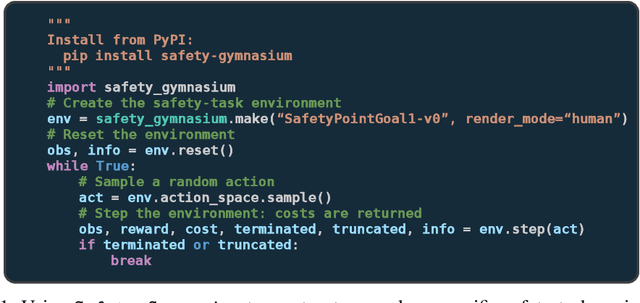

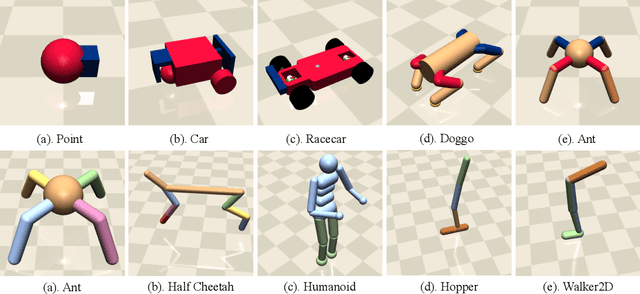
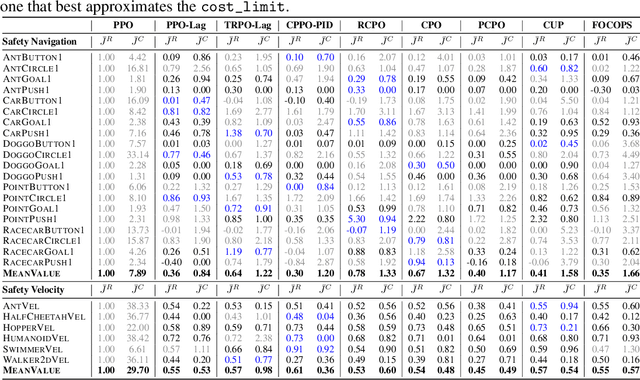
Abstract:Artificial intelligence (AI) systems possess significant potential to drive societal progress. However, their deployment often faces obstacles due to substantial safety concerns. Safe reinforcement learning (SafeRL) emerges as a solution to optimize policies while simultaneously adhering to multiple constraints, thereby addressing the challenge of integrating reinforcement learning in safety-critical scenarios. In this paper, we present an environment suite called Safety-Gymnasium, which encompasses safety-critical tasks in both single and multi-agent scenarios, accepting vector and vision-only input. Additionally, we offer a library of algorithms named Safe Policy Optimization (SafePO), comprising 16 state-of-the-art SafeRL algorithms. This comprehensive library can serve as a validation tool for the research community. By introducing this benchmark, we aim to facilitate the evaluation and comparison of safety performance, thus fostering the development of reinforcement learning for safer, more reliable, and responsible real-world applications. The website of this project can be accessed at https://sites.google.com/view/safety-gymnasium.
OmniSafe: An Infrastructure for Accelerating Safe Reinforcement Learning Research
May 16, 2023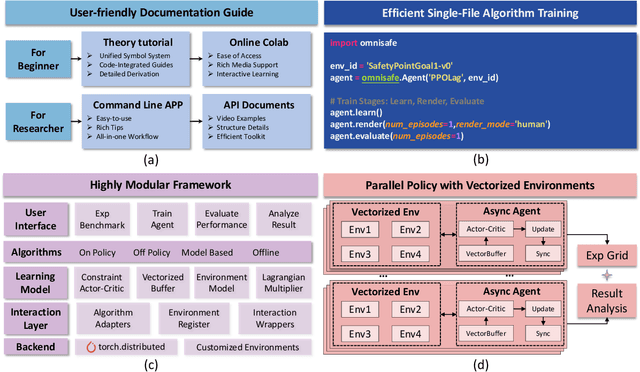
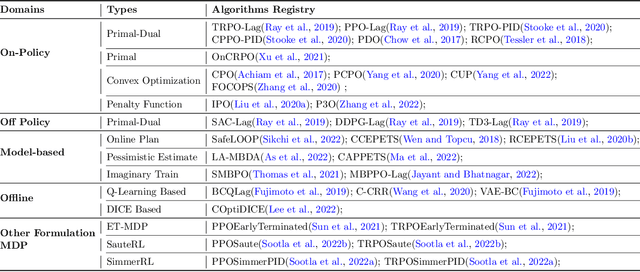
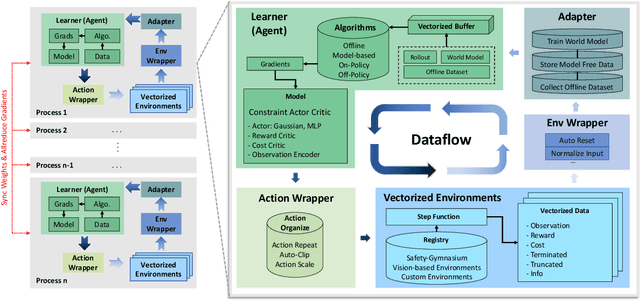
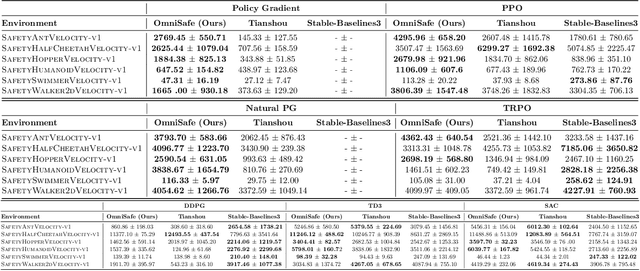
Abstract:AI systems empowered by reinforcement learning (RL) algorithms harbor the immense potential to catalyze societal advancement, yet their deployment is often impeded by significant safety concerns. Particularly in safety-critical applications, researchers have raised concerns about unintended harms or unsafe behaviors of unaligned RL agents. The philosophy of safe reinforcement learning (SafeRL) is to align RL agents with harmless intentions and safe behavioral patterns. In SafeRL, agents learn to develop optimal policies by receiving feedback from the environment, while also fulfilling the requirement of minimizing the risk of unintended harm or unsafe behavior. However, due to the intricate nature of SafeRL algorithm implementation, combining methodologies across various domains presents a formidable challenge. This had led to an absence of a cohesive and efficacious learning framework within the contemporary SafeRL research milieu. In this work, we introduce a foundational framework designed to expedite SafeRL research endeavors. Our comprehensive framework encompasses an array of algorithms spanning different RL domains and places heavy emphasis on safety elements. Our efforts are to make the SafeRL-related research process more streamlined and efficient, therefore facilitating further research in AI safety. Our project is released at: https://github.com/PKU-Alignment/omnisafe.
 Add to Chrome
Add to Chrome Add to Firefox
Add to Firefox Add to Edge
Add to Edge